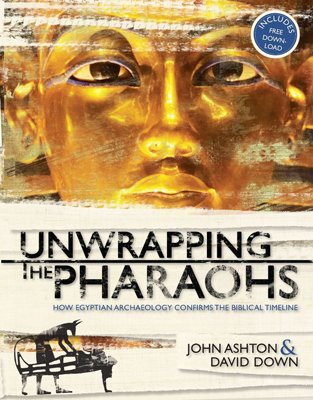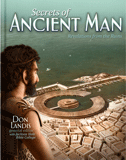
Chapter 10
How Do We Know What Happened?
Before dealing with the Middle Kingdom, which brought Egypt to a pinnacle of power and affluence, it is necessary to discuss the sources of information on which our knowledge of this era is derived.
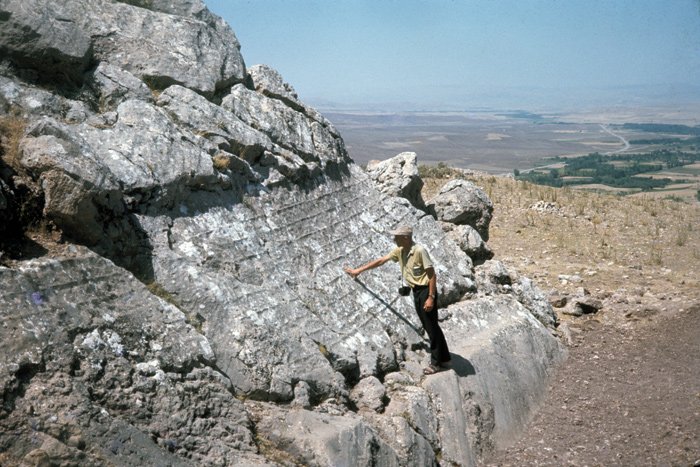
Supiluliumas carved this king-list on the rock face at Hattusis, the Hittite capital. He wrote to Akhenaten of Egypt, who is usually dated to the 14th century B.C., but Shalmaneser III of Assyria records his war against Supiluliumas in the 9th century B.C. Something is wrong somewhere.
The casual tourist to Egypt will notice and read the captions on the tombs at Saqqara, Luxor, and elsewhere. The historical details appear to have been all worked out, the “facts” are all cut and dried. The dates of dynasties and kings seem to be as specific and as sure for ancient Egypt as they are for World War I. The same can be said for the books with glossy pages and color pictures that are available from bookshops. Some authors will even jubilantly extol their sources by writing that the chronology of Egypt is “astronomically fixed.” However, the careful observer might be surprised to compare two of these books and find that each are equally positive about their dates, but they have different dates for the same kings.
All archaeologists would like to think that the dates and history of Egypt have been accurately determined, but they know better. Most of the books about Egypt are written by journalists who wax enthusiastic about the facts and dates that are at our disposal. In reality, there are more questions than answers when it comes to the facts of Egyptian history and the times of various events.

Bible chronology can be synchronized with Assyrian history very accurately. This 6.5 foot (2 m) high pillar now in the British Museum depicts Shalmaneser III receiving tribute from the Israelite king Jehu whose history is recorded in 2 Kings 9 and 10. The Bible date for Jehu’s reign is 841–814 B.C. and the Assyrian date for Shalmaneser is 859–824 B.C.
There are three main sources for the information we have. First, there are the writings of ancient historians, which include Herodotus, Manetho, Josephus, and the Hebrew Bible. Second are the inscriptions carved into temple walls, statues, and artifacts. Third, there are the hundreds of papyrus documents that have come to light. All put together, they should tell one harmonious history. Unfortunately, they don’t.
When a king wrote on a statue that it was made in his tenth year, that does not tell us how long he reigned. It only tells us the minimum number of years he reigned. It could have been much longer than that. Moreover, that tenth year may have been from when he was crowned as a co-regent. He may not have come to the throne until many years later when his father died.
The inscriptions on buildings and temple walls often consist of long texts that tell of battles and achievements, but we should never forget that pharaohs did not put these inscriptions there to provide us with a history of Egypt. They were incised there to immortalize the deeds of the pharaohs, and it would be too much to expect historical accuracy from them. No doubt they provide clues, but it was only natural for them to inflate their victories to glorify their names.

On the Lachish reliefs in the British Museum, Israelite prisoners are shown being sent into exile by the Assyrians under Sennacherib, whose capture of Judean cities is recorded in 2 Kings 18:13.
The written records also have to be carefully analyzed. Herodotus was a Greek traveler who visited Egypt in the fifth century B.C. He does not always say what happened. He simply reported what the priests or people told him. That is good journalism. Herodotus did not always believe what he heard, but he recorded it for his readers’ information.
Most of the early archaeological conclusions were based on the writings of Manetho, an Egyptian priest who wrote in the third century B.C. The history of the pharaohs had ended. Alexander occupied Egypt in 332 B.C. and that was the end of the Egyptian dynasties. They were followed by a line of Greek rulers known as the Ptolemies. It was Ptolemy II who asked Manetho to put together a history of Egypt for the library at Alexandria.
No doubt, Manetho did his best. He undoubtedly could read the Egyptian hieroglyphs and had access to the many inscriptions and documents that existed in his day, but after all, that day was after Pharaonic history was ended. There is no guarantee that he wrote accurately or that his source materials were accurate. More troubling still is the fact that Manetho’s writings do not exist. They have been long since lost. The only source we have for what he wrote are the statements he made that have been quoted by subsequent historians.

The Nile god Hapy is frequently depicted as tying Upper and Lower Egypt together. He was also supposed to be the god of fertility.
Josephus, the Jewish historian, writing in the first century A.D., quoted from Manetho. Bishop Eusebius writing in the fourth century A.D. quoted from him. However, there is a further problem in that we don’t have all the original writings of some of these authors, and, so, we have the Armenian version of Eusebius and quotations in the writings of Syncellus, A.D. 800, and Africanus, third century A.D. When we compare these sources, we find that they frequently disagree with each other. So, quite bluntly, we cannot be sure of what Manetho originally wrote.
That is all something over which we have no control, but there is one factor that early scholars chose to ignore. They happily added up all the lengths of reigns and years of dynasties given by Manetho and came up with some huge figures for the dates assigned to these rulers and dynasties. They mostly ignored Eusebius’ statement that “several Egyptian kings ruled at the same time. . . . It was not a succession of kings occupying the throne one after the other, but several kings reigning at the same time in different regions.”1
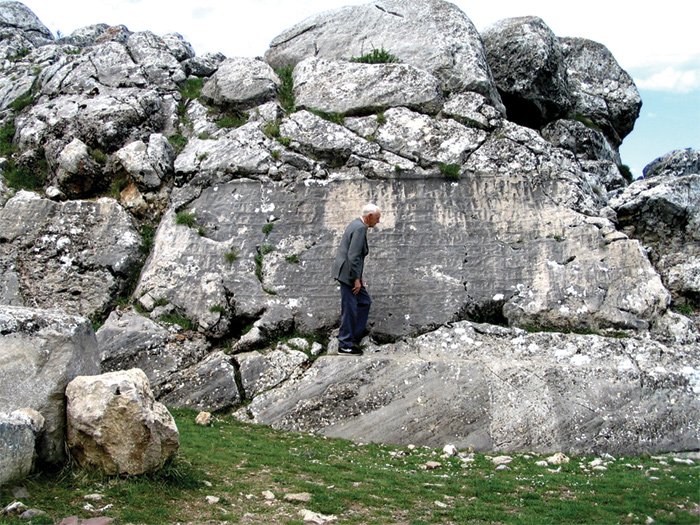
The author inspects the king-list left by Supiluliumas on the rock face in the Hittite capital city of Hattusis, now called Boghazkale, in Turkey.
It is not a matter of whether some dynasties were contemporary rather than successive, but how many dynasties were contemporary and for how long. Modern scholars recognize that some dynasties were reigning at the same time. In fact, at one point in the 8th century B.C. there were four dynasties ruling at the same time, and some scholars claim that some of the earlier dynasties were contemporary. This would naturally drastically reduce the dates of these early dynasties.
The concept of Egyptian dates being astronomically fixed gives the reassuring impression that some early lunar or solar eclipses have been found to exactly match the assumed dates of Egyptian history. Nothing can be further from the truth. The idea of astronomical fixation is based not on eclipses but on the so-called “Sothic Cycle,” which David Rohl, in his book Test of Time calls a “weird and wonderful thing.”2 He suggests, for example, that “Rameses II should be dated to the tenth century B.C.—some three hundred and fifty years later than the date which had been assigned to him in the orthodox chronology.”3

A recently discovered Hittite hieroglyphic inscription in Hattusis, the Hittite capital. Hittite hieroglyphs were written “as the ox ploughs” so that each line began at the same side as the previous line ended.
The Sothic Cycle is nowhere mentioned in Egyptian texts. There are some references to “the rising of Sothis,” which is assumed to have been the sighting of the bright star Sirius after it had been obscured by our earth’s orbit around the sun. It is further assumed that the Egyptians always had a 365-day year, whereas we know the year is 365 and a quarter days long. It was therefore assumed that over a period of four years the Egyptian new year would be one day in arrears. After 40 years, that Egyptian new year would lag ten days behind, and over a period of 1,460 years, the Egyptian new year would come back to its starting point, and this was the “Sothic Cycle.”
This was really an astonishing theory which assumed that the brilliant Egyptians, who could orient their pyramids to within a fraction of a degree to north, south, east, and west, were not aware that their new year was wandering around like that. Needless to say, not all archaeologists concurred with this theory, but in the absence of any other method to verify their dates they went along with it anyway. Now, recent discoveries are changing the views of some scholars, and chronology is becoming a hot issue in archaeological circles.
In 1991, Peter James, who graduated from Birmingham University, and four other scholars published a book called Centuries of Darkness. They also trashed the Sothic Cycle and claimed that the dates of Egyptian dynasties needed to be reduced by centuries. Dr. Colin Renfrew, professor of archaeology at Cambridge University, wrote a foreword to this book in which he said, “This disquieting book draws attention, in a penetrating and original way, to a crucial period in world history, and to the very shaky nature of the dating, the whole chronological framework, upon which our current interpretations rest. . . . The revolutionary suggestion is made here that the existing chronologies for that crucial phase in human history are in error by several centuries, and that, in consequence, history will have to be rewritten. . . . I feel that their critical analysis is right, and that a chronological revolution is on its way.”4
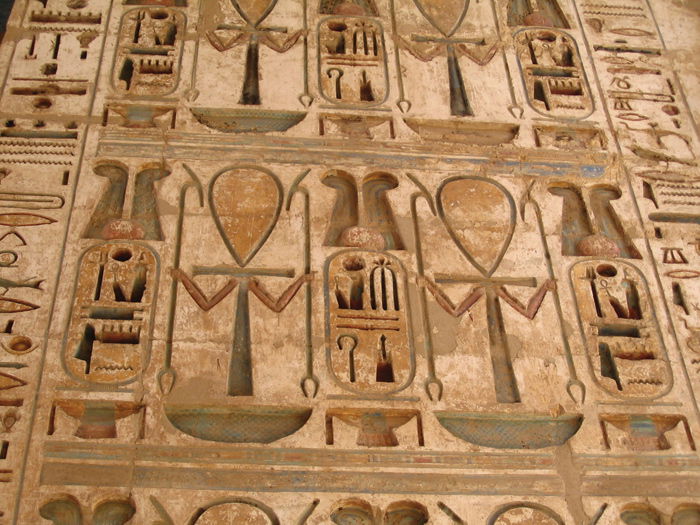
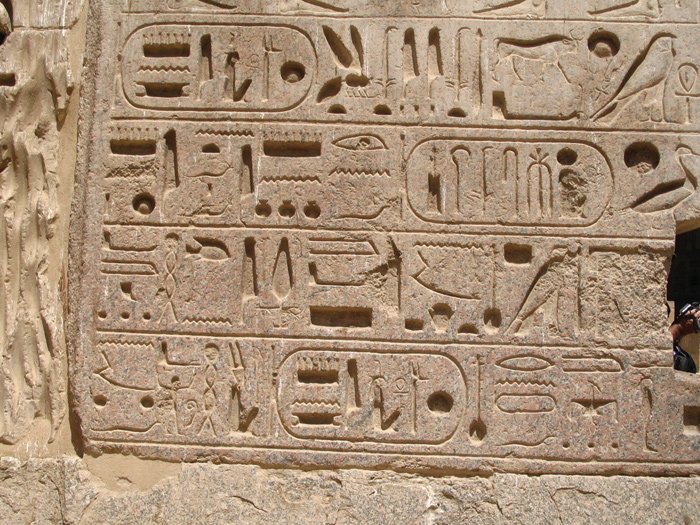
Two beautiful, deeply engraved Egyptian inscriptions from the temple of Rameses III at Medinet Habu near Luxor. Egyptian hieroglyphs could be written left to right, right to left, or top to bottom.
The villain in the piece is, of course, the third intermediate period, consisting of Dynasties 21–24. Very little is known about this period, and these scholars say that the reason is that it did not exist, at least as independent dynasties, and if these dynasties are to be placed contemporary with each other or with other dynasties, this would dramatically reduce the dates assigned to all the earlier dynasties.
As the interpretation of history is totally dependent on a correct chronology, the revised dates will have a profound effect on history as we know it, and it will clarify some of the troubling problems that at present beset historical writers.
One serious problem that will need to be resolved is the dating of the Hittite Empire. The Hittites have no chronology of their own. Their dates are entirely dependent on synchronisms with Egypt. When Akhenaten came to the throne, the Hittite king Supiluliumas sent him a letter of congratulation. It was found among the Tel el Amarna letters. From this it can be concluded that Supiluliumas reigned at the same time as Akhenaten. Great. So, if we have the correct dates for Egyptian history we have the correct dates for Hittite history, but if the dates of Egyptian history are to be reduced by centuries, so will the dates for Hittite history.
That immediately helps to solve another problem that has bothered some scholars. The Hittites are supposed to have been overrun by the peoples of the sea about 1200 B.C. and ceased to exist as a nation, but in the ninth century B.C. we find the Assyrian king Shalmaneser III fighting an all-out war against the Hittites. In the eighth century B.C., Sennacherib recorded his wars against the Hittites—rather hard to explain if the Hittites ceased to be a nation 400 years earlier.

The Taylor prism in the British Museum tells how Sennacherib “shut up Hezekiah like a bird in a cage.” His siege of Jerusalem is recorded in 2 Kings 18:17. Each record states that Hezekiah paid Sennacherib “30 talents of gold” (verse 14).
More amazing still are the names of the Hittite kings which appear to be the same in the 13th century as in the 9th century. Remarkable coincidence? No, obviously they were the same kings, only by synchronizing them with conventional Egyptian chronology would they have been in the 13th century B.C., but when we synchronize the Hittite history with Assyrian history, we find the activities of the Hittites would have been in the 9th century. Assyrian records continue to refer to Syria and the Taurus area as the “Land of Hatti,” and speak of kings bearing names like Sapalulme, Mutallu, Katuzili, and Labarna (cf. Suppiluliumas, Muwatallis, Hattusilis or Kantuzzilis, Labarnas).5 It was Suppiluliumas who brought the Hittite empire to power during the latter part of the reign of Pharaoh Amenhotep III and Pharaoh Akhenaten.
The Hebrew Bible also refers to the Hittites as a powerful army in the ninth century B.C. It tells how the Syrian army lifted their siege of Samaria and fled in disorder, “For the Lord had caused the army of the Syrians to hear the noise of chariots and the noise of horses—the noise of a great army; so they said to one another, ‘Look, the king of Israel has hired against us the kings of the Hittites and the kings of the Egyptians to attack us!’ ” (2 Kings 7:6).
Whether this was the reason the Syrians fled or not is irrelevant. The point is that the Hebrew writer considered not only that the Hittites existed in force in the ninth century, but he placed them ahead of even the mighty Egyptian army. If the Hittites were obliterated around 1200 B.C., this verse would be an anachronism, but if Egyptian dates are to be reduced, it would be at a time when the Hittites really were a dominant force in the Middle East. In fact, it was a time when the Hittites were successfully challenging the great Egyptian Empire.
The obvious solution to these apparent anomalies is to recognize that the dates of Egyptian history need to be reduced, and that will automatically reduce the dates of Hittite history that will make them consistent with the Assyrian and Hebrew records.
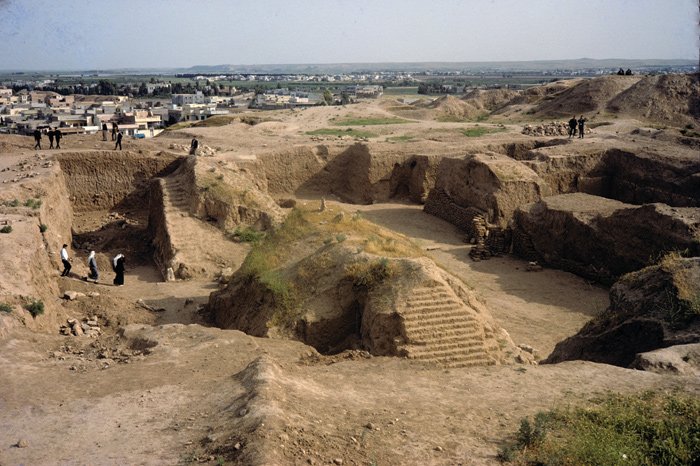
Excavations at the palace of Sennacherib at Nineveh in northern Iraq. The city of Mosul is in the background.
Can we justifiably meddle with the dates of Egyptian history? Some seem to regard Egyptian chronology as a sacred cow which must not be disturbed, but it is not as secure as some would like to think. Sir Alan Gardiner is a respected authority on Egyptian history, but he frankly admits the problems involved in putting it all together. He wrote, “Even when full use has been made of the kinglists and of such subsidiary sources as have survived, the indispensable dynastic framework of Egyptian history shows lamentable gaps and many a doubtful attribution. If this be true of the skeleton, how much more is it of the flesh and blood with which we wish it were covered. Historical inscriptions of any considerable length are as rare as the isolated islets in an imperfectly chartered ocean. The importance of many of the kings can be guessed at merely from the number of stelae and scarabs that bear their names. It must never be forgotten that we are dealing with a civilization thousands of years old and one of which only tiny remnants have survived. What is proudly advertised as Egyptian history is merely a collection of rags and tatters.”6
So, instead of relying on Egyptian history and dates, and calculating the dates of neighboring countries on the basis of synchronizing with Egypt, it is essential to consider the evidence from Assyria, the Hittites, ancient Greece, the biblical records, and the archaeological ages of Palestine to correctly date the events of Egyptian history. This will inevitably require a reduction of Egyptian dates.
Unwrapping the Pharaohs
Adults and children alike are fascinated by Egyptian civilization. But most modern archaeologists have lately tried to use Egyptian chronology to dispute the biblical record. Secular textbooks and videos challenge the faith of students and discredit the biblical account of Exodus. Those who wish to defend the accuracy of the Bible now have an incredible tool in this exciting book that provides compelling confirmation of the biblical account.
Read Online Buy BookFootnotes
- Waddell, History of Egypt and Other Works by Manetho, p. 9.
- David M. Rohl, A Test of Time: The Bible—from Myth to History (London: Century Limited, 1995), p. 128.
- Ibid., p. 143.
- Peter James, Centuries of Darkness (London: Pimlico, 1992), p. XV-XVI.
- Ibid., p. 39.
- Allan Gardiner, Egypt of the Pharaohs (London: Oxford University Press, 1964), p. 53.
Recommended Resources

Answers in Genesis is an apologetics ministry, dedicated to helping Christians defend their faith and proclaim the good news of Jesus Christ.
- Customer Service 800.778.3390
- © 2024 Answers in Genesis

